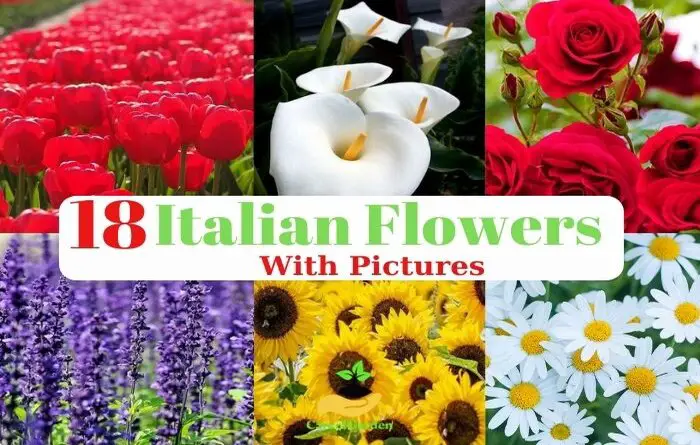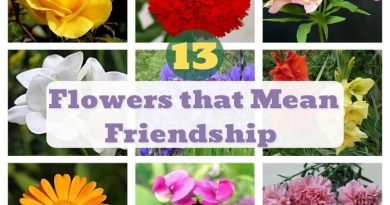18 Beautiful Italian Flowers You Need To See (With Pictures)
Italian flowers are a part of the Italian culture and tradition. In fact, Italians love flowers so much that they constantly organize festivals of them.
Bright and colorful in any season, you can find Italian flowers on balconies, in homes, in the countryside, and often as gifts. In Italy it is popular to send a bouquet of flowers for any occasion.
Italy has a wide range of climates, which in turn produce a wide variety of flowers. Italian culture is full of symbolism about the flower. The color or variety of the flower you intend to send or give to someone is of great importance in Italy. The Mediterranean is home to exotic tropical flowers, while northern Italy is rich in wildflower fields.
Flowers are very present in Italy, both filling the wild fields in spring, and in the cut flower trade, which is very heated throughout the year. Italians are also famous for their well-kept gardens and the habit of putting flowers on the porch.
In this new article, we have made a list of types of Italian flowers.
| Type of Italian Flowers: |
|---|
| Tulip |
| Orchid |
| Chrysanthemum |
| Sunflower |
| Daisy |
| Lavender |
| Carnation |
| Rose |
| Calla Lily |
| Lily |
| Freesia |
| Oleanders |
| Peony |
| Violet |
| Cyclamen |
| Jasmine |
| Poppy |
| Daffodil |
| Bellflower |
| Azalea |
| Mimosa |
| Gardenia |
| Bluebell |
| Crocus |
Italian flowers
1. Tulip
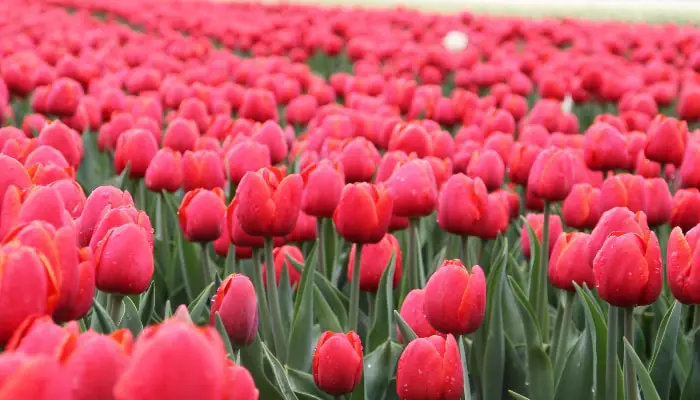
The Tulip is a beautiful italian flower belonging to the Liliacee family. It is renowned and appreciated for its intense and sweetish scent. Tulip flowers can take on different shades, unlike the leaves which are of a characteristic extremely intense green.
Depending on the variety, it can have different dimensions since there are tall and dwarf ones, however the maximum size that can reach is around thirty centimeters, and hardly goes beyond.
The multiplication of the Tulip can take place through sowing or through bulbils. In the first case, the seeds of the fruit must be collected and left to dry, burying them in rich soil: germination does not occur before six years. In the second case, the cloves must be kept in a cool and dry place until the moment of planting.
The fertilization of the Tulip should be done with a common fertilizer for flowering plants, to be administered regularly from when the plant blooms for about four weeks.
2. Orchid
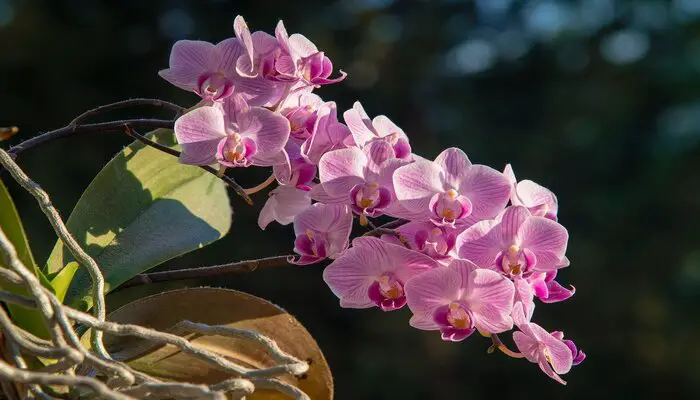
It is commonly known as the Orchid, due to its variety of species. There are about a thousand species, distributed in the territories of Southeast Asia, but also in Italy, thus changing specific characteristics, starting from the size. They can be from a few centimeters to two or three meters high.
The plants for most of the species are epiphytes with evergreen or deciduous leaves. The flowers can develop either from the pseudobulbs, which are swellings in the stems but not real flower bulbs, or directly along the original stem, depending on the specific species.
The colors of the orchid flowers cover a wide range of shades as many hybrids have been created with different shades but the original and primary colors of the orchid are still yellow, pink and white.
The leaves of the Orchid are small and resistant, slightly swollen. Precisely for the beauty of the flowers, for their elegance and delicacy, the Dendrobium is considered a houseplant or garden plant.
3. Chrysanthemum
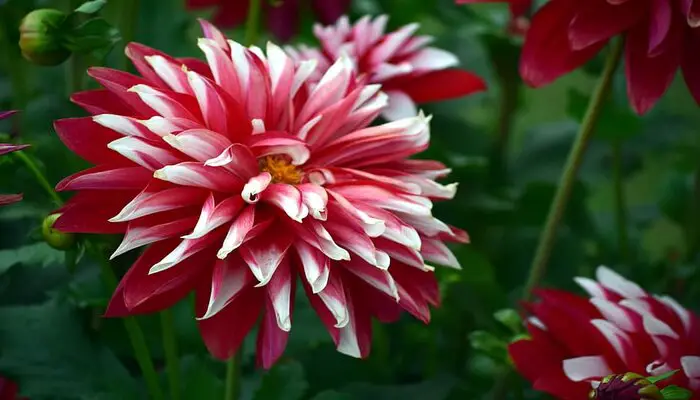
The chrysanthemum is part of the Asteraceae family (Composite) and has the scientific name Chrysanthemum spp. The chrysanthemum originates from Italy and is declared the national Italian flower representing the symbol of longevity and joy.
Chrysanthemum is a herbaceous plant with a bushy appearance. Its height reaches up to 30 cm and is very easy to grow. The chrysanthemum blooms in late summer, autumn or winter. It has a rich spherical texture and diversified colors.
4. Sunflower
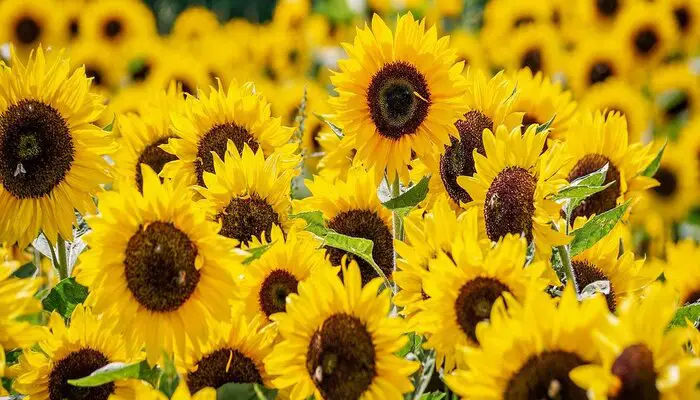
The sunflower is a traditional Italian flower that supports almost everything; it withstands the drought, although from time to time it needs a little water, and the land of varied acidity.
Not only can it survive a wide variety of environmental conditions, but it also produces a large number of seeds that benefit birds, other pollinators, and even humans.
It is a plant with a right stem of about three centimeters thick and approximately two meters high, alternate and heart-shaped leaves and terminal yellow flowers that, due to their weight, bend at maturity, offering their seeds in the form of pipes.
Sunflowers grow best when in full sun, and bloom during the summer or early fall. They prefer long, hot summers when they bear seed-filled flowers and beautiful petals.
5. Daisy
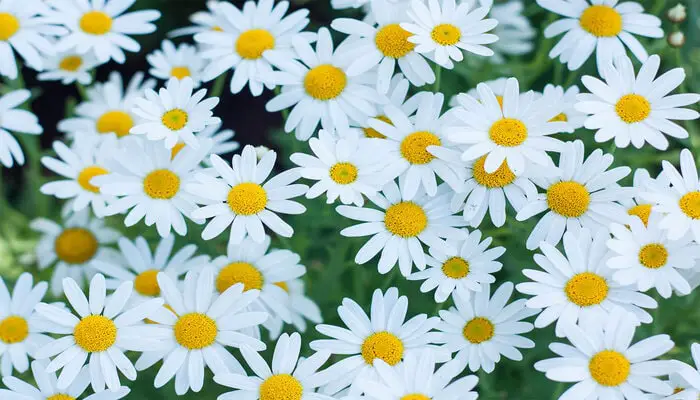
Daisies are very popular Italian flowers. Very often we see them in gardens, but also in beautifully arranged spaces in cities. They can be dwarf or very tall, have fine and elegant flowers, are relatively easy to care for and are resistant to disease.
This flower is varied when it comes to colors. Some people prefer yellow daisies, others white, purple, orange or other shades. The good part is that you will find many colors to choose the one you prefer. Also, depending on what you like or what effect you want, you can opt for dwarf daisies or higher variants.
Daisy, a delicate Italian flower, which is found in many beautifully decorated green spaces, is quite simple to differentiate from other plants. It has a grassy stem with a single flower at the end. It often has petals distributed in a single row and thin, green leaves.
This flower is sensitive to very low temperatures, so you need to protect it from frost. To prevent the daisies from freezing, the bush should be cut as close to the ground as possible, at a distance of only a few centimeters and covered with a mixture of earth and sand.
6. Lavender
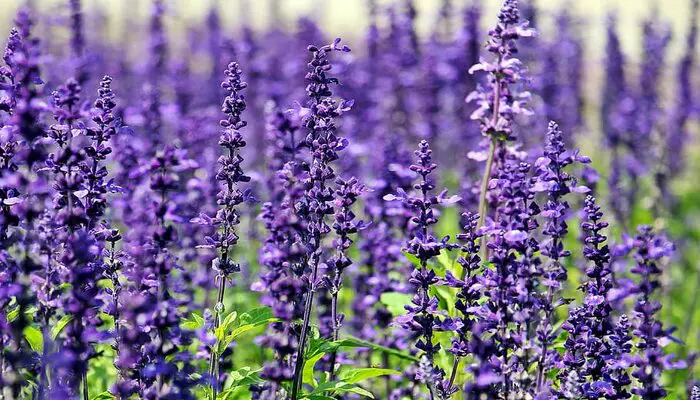
Lavender is a small Italian flower belonging to the Lamiacea family. It grows in the Mediterranean basin and can reach a height of just under one meter. It is a evergreen, herbaceous plant, and is present in about 25 varieties, among which the most common are Lavanda Angustifolia and Lavanda Dentata.
Lavender is composed of erect branched stems, woody at the base. It has greenish-gray lanceolate leaves, produces fruits called achene, which contain only one seed inside.
The inflorescences appear as spikes placed at the apex of the stems, the flowers are purple in color and very fragrant, therefore they are suitable for storage in bags to spread their aroma inside cabinets and drawers. Lavender is also widely used for herbal purposes.
The name derives from the Latin and indicates “which must be washed”; in fact, especially in the Middle Ages, this plant was used to take care of personal hygiene.
At the end of flowering, when the summer season ends, twigs of about 10 or 15 centimeters can be taken to favor reproduction by cuttings. The twigs should be placed in a soil of peat and sand, the pot should be covered to maintain the right humidity and temperature. When the first sprouts appear, the pot must be changed.
7. Carnation
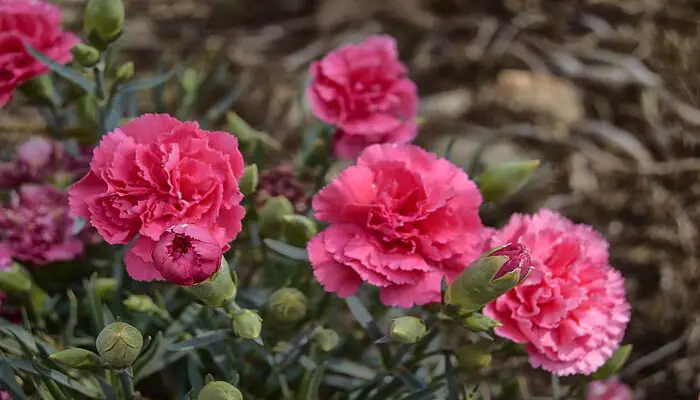
When it comes to Carnations, a world opens up which includes almost three hundred species belonging to the genus Dianthus. All species in the genus have in common graceful flowers, generally fragrant and with gray-green leaves.
The genus Dianthus is very vast and very varied and boasts a great ability to hybridize therefore it has countless cultivars. Carnations are some of the most famous Italian flowers and are found in a multitude of colors and species. Carnations can be found in almost all temperate zones of the globe. The height of the Carnations varies from 10 cm to over 80 cm.
The petals can be variegated or edged in a different color. The corollas can be single, double or stradouple. The leaves are opposite, linear or lanceolate.
The flowers are carried on gnarled stems, often with a woody base (in some, however, also in small bunches or umbrellas) with five petals (in simple forms) fringed and sometimes with an intense perfume. At the end of the summer they form capsules with numerous seeds.
Carnations can be grown from seed, which is sown in early spring indoors, in greenhouses or in pots on the balcony or terrace. On the outside, they must be sown after the danger of frost has passed, more precisely after April 15. Being perennials, carnations can be propagated by seedling or division of bushes, once every 2-3 years, in the case of mature plants.
8. Rose
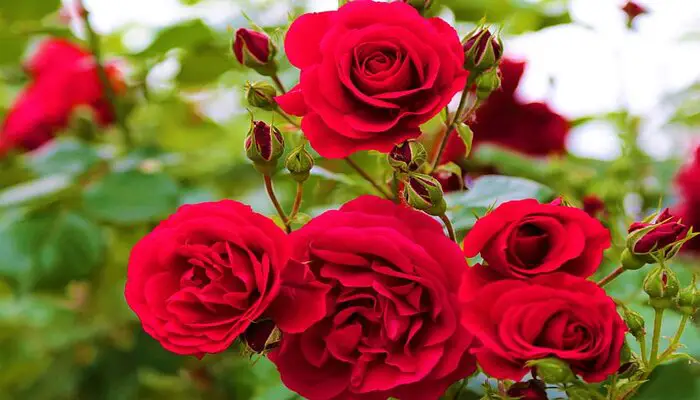
The rose is a flower belonging to the Rosaceae family, which is very popular all over the world. Roses are traditional Italian flowers and are some of the most beloved flowers in the world, being a symbol of love and passion. There are over 200 species of roses and they are used both as ornamental plants and in culinary or cosmetic preparations.
It is one of the best-selling flowers in the world, along with tulips and carnations. Its trade is also driven by the fact that it is one of the main ingredients in perfumes, creams and other cosmetics.
In addition, since ancient times it has been suggested that this flower has medicinal uses, some of which are still used in various parts of the globe.
Roses adorn people’s gardens and homes, being appreciated for their beauty, but also for the fact that they are not pretentious flowers, and their planting and care can be done easily.
If you have a garden, it is best to choose to plant your rose outside, because it is a flower that needs a lot of sunlight and can grow up to a meter, or more if it is a climbing specimen. But if you do not have this option, do not worry: there are also species suitable for an apartment.
9. Calla Lily
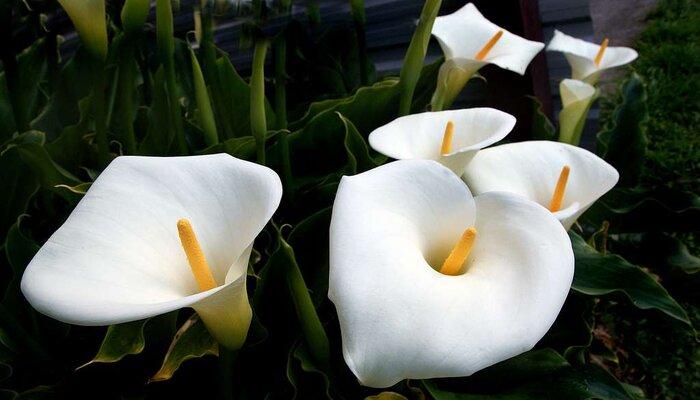
Calla Lily are well-known inflorescence Italian flowers, rhizomatous, evergreen in nature. It is very well known for the enchanting qualities of its flowers, with bright and sparkling colors and is also known by the name of Zantedeschia, belonging to the Araceae family. It is generally used to decorate artificial cows, ponds or it is grown at home or in a greenhouse to use the cut flower.
Calla Lily reaches a height of about one meter. Its rhizome is very long, of great thickness. Therefore, this underground rhizome constitutes both the stem and the reproductive organ of the plant. The leaves of the Calla are placed at the base and covered with very wide ribs, depending on the species they can be oval, lanceolate or sagittate.
Their petioles are particularly long. Depending on the species, they bloom in spring or in the very first times of the summer season. The inflorescences produced by the plant are very ornamental and of the most varied colors: from white, to yellow, to red, to pink, to cream. The flowers are funnel-shaped, solitary and monoecious.
The reproduction of the Calla Lily flower takes place by sowing or by division of the tufts. Generally, the latter is the most used method as it occurs simultaneously with repotting. In this case it is sufficient to divide the rhizome into several parts, each of which has at least two shoots, and place them at a depth of about 10 cm.
The substrate to be used must consist essentially of fertile soil and peat. The pot obtained is placed at a minimum temperature of 20 ° – 25 ° C and is watered from time to time. At the sprouting of the sprouts, with a minimum height of 20 cm, the seedlings can be placed in larger pots and treated as adult plants.
10. Flame Lily
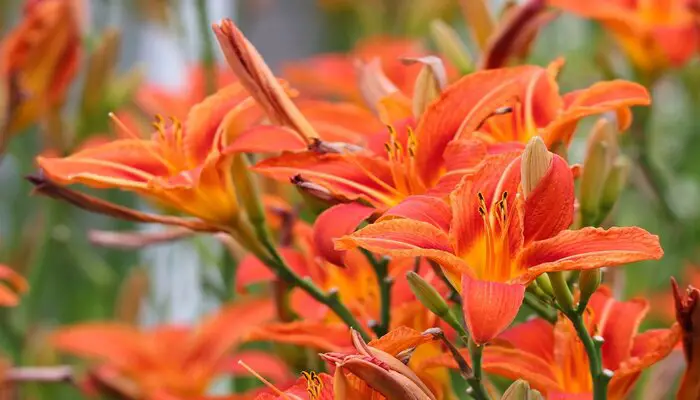
The lily stands out for its scent, its elegant shape and the variety of extraordinary colors of the petals that create infinite color combinations. As a bulbous cut flower, the lily is also the perfect ornament for any type of environment.
This flower (botanical name Lilium ) is a native Italian flower belonging to the Lialiaceae family , the same as other ornamental plants such as tulip , lily of the valley and hyacinth. Lily is one of the most loved fragrant garden Italian flower for its regal appearance, exotic fragrances and beautiful blooms that it is able to give.
The lily plants can be reached in height between 80 cm and 2 meters . The bulbs are well branched but unlike the other bulbs they are not renewed every year .
The leaves of the lily grow on long, strong stems . They have a lanceolate shape and are fleshy and intense in color. The flowers consist of 6 petals with changing shapes and colors, very open and fragrant.
In all, there are 80 species (in addition to hybrid varieties) that this bulbous has. The colors range from white, pink, lilac, red, yellow, orange, purple through all the intermediate shades.
Some varieties of eyelashes emit fragrances that are too intense and sweet. Others, on the other hand, have more discreet fragrances that are better suited to closed environments. The hybrid varieties , for example, give off hints of vanilla while the Asian ones are even more delicate and pleasant. In the garden, however, this problem does not arise.
The sowing process of the bulbs should be done at a depth of about 20 cm. The bulbs are planted with the roots down, and then the soil is compacted very well and watered with a moderate amount of water. Avoid over-combining the soil, as the bulbs may rot. The recommended planting distance between the bulbs is at least 20 cm to a maximum of 25 cm.
11. Freesia
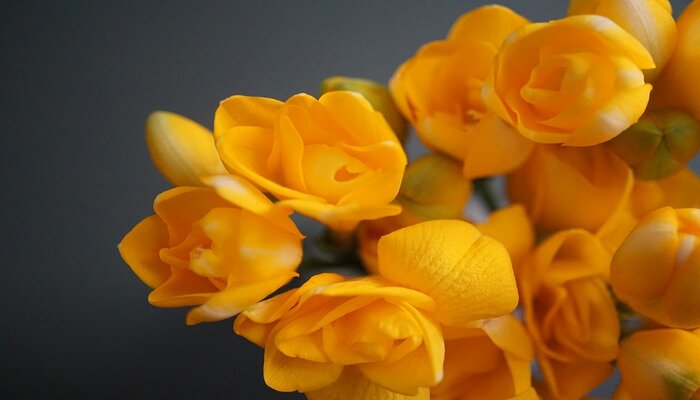
The freesia flower is a bulbous plant of the family of spring Iridaceae native to South Africa but cultivated in almost all Italian regions. Freesia is a small Italian flower with an average height of no more than 30 centimeters . The root is a small bulb or ovoid corm that is firmly anchored to the ground thanks to a long whitish root.
The aerial part of the freesia is composed of thin cylindrical stems covered with a few leaves. The leaves , bright green like those of the iris, have the shape of a sword, are 20-30 cm long si about 2 cm wide. During the flowering period, between the tuft of leaves, floral scapes appear with spiked inflorescences composed of clusters of fragrant flowers.
The flowers , 6-12 per cluster, are bell-shaped and have a corolla composed of petals welded to the base whose color varies from pure white to cream, from yellow to bright shades of orange and red, from blue to purple . In hybrid cultivars the petals of freesias have contrasting veins or spots of color.
The seeds are large, rounded and with a very high germination capacity. At the apexes of the stems, during the flowering period, racemes appear formed by simple or compound flowers, intensely perfumed, with a bell-shaped corolla.
To be able to produce flowers in profusion, the freesias must be fertilized every 10-15 days, before flowering and for the whole vegetative cycle with specific fertilizers for flowering plants in liquid form, suitably diluted in the watering water. Alternatively, once a month, distribute a slow-release granular fertilizer at the foot of the seedlings.
In many regions of Italy and especially in Liguria, freesia is cultivated for commercial purposes for the production of cut flowers at the end of winter or in spring, to embellish the interior of houses, to create floral arrangements for ceremonies and wedding banquets.
12. Oleanders
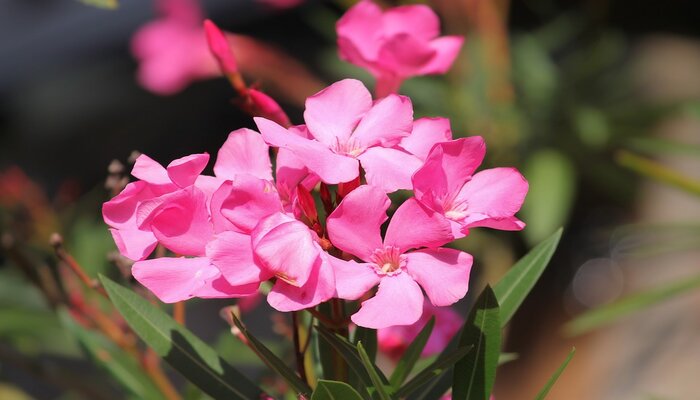
The oleander is popularly known as flower laurel or laurel rose. It belongs to the Apocinaceae family and its scientific name “Nerium” is given by a marine deity called Nereus, famous in mythology for his daughters, the Nereids.
Also striking is its Basque name, “Eriotz-orri”, which means death leaf, due to its toxicity. This is due to the powerful toxins it possesses. It can cause nausea, dizziness, arrhythmias, seizures, and even cardiac arrest. It is important to know all these data before choosing to have one or another plant in the garden, especially if there are small children living in the house.
The sale in Italy of Oleanders for medicinal uses is prohibited due to its toxicity and its commercialization is restricted to the preparation of pharmaceutical specialties, homeopathic strains and research. The oleander is a shrub that can reach 4 meters in height and has a gray and brown bark.
Its flowers have a very intense fragrance and stand out for their diverse colors ranging from white to red through yellow. They are bouquet-shaped and flower in June, with a fairly long flowering period. This italian flower is found in river flows, but it can also be found in streets and avenues.
Oleander is a sunny plant and does not need too much watering. It is very resistant to drought thanks to its roots, which are always looking for water, so it will not be necessary to water it often.
The irrigation will be made only during the summer season because the rain water from other times is enough. In the event that the oleander is planted in a pot, it will be convenient to water it daily.
It is very important to keep this plant out of the reach of the smallest of the house, since if its fruits are ingested, cases of poisoning and, in the worst cases, death can occur. Its growth is quite fast, it can exceed several meters in a few years although if a specific pruning is carried out, in fact, it favors its growth and branching.
You can use the oleander as a hedge or as a small tree, it will depend on the pruning you do. The most drastic should be done at the end of winter so that the bush can recover.
13. Peony
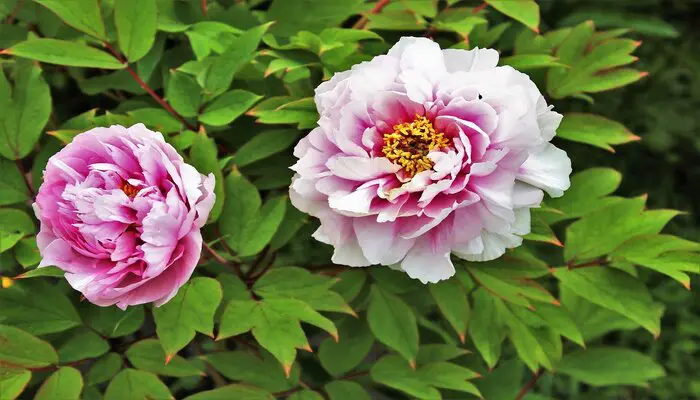
Before starting to see what are the jobs you will have to do to grow your Italian peonies flowers, it is good to know that you can choose from many species, which are basically divided into two broad categories: shrub peonies and herbaceous peonies .
The peonies flowers, is a native Italian flower characterized by robust woody branches on which sprout in the spring very colorful flowers and many leaves. The main feature of shrub peonies is that they grow above all in height and width, taking the shape of a real bush that can reach a considerable size of about 2 meters. These peculiarities of the shrub peony make it really easy to grow and perfect in adapting to the coldest temperatures of winter.
Herbaceous peonies, on the other hand, have the aerial part that dies during the winter, without however causing the entire plant to die. In fact, its fleshy roots accumulate all the nutrients that function as an energy reserve, making them overcome the cold season without excessive damage.
Herbaceous peonies emit a single herbaceous stem with leaves that has floral buttons on its top. Unlike shrub peonies, the herbaceous ones grow horizontally always remaining the same height that reaches a maximum of one meter.
As we have said, there are really many species of peony, usually the herbaceous ones are ornamental, and therefore can also be grown in pots inside your home, while shrub peonies, due to their size, are ideal to use as a hedge or isolated bushes in the garden.
We do not recommend starting from the seed to grow peonies, because it is a very long process that can give you results only after 5-8 years, while starting from the tufts accelerates the growth and flowering process.
The planting, which can vary slightly from species to species, can be done at the end of the flowering cycle, around October. Dig 5cm holes, bury the clumps and cover them with a light layer of compost .
Their flowering is luxuriant and lasts for the entire duration of spring, continuing in some species even in summer.
If you want to harvest peony flowers, do so when the buds begin to be soft and show the color of the flower, in this way you will make them last longer than harvesting when the flower is already open. Plus, you can make your cut flowers last even longer by adding a little vinegar to the vase water.
The peonies are planted at a distance of 130-150 cm from each other. For herbaceous peonies , on the other hand, the distance to be respected between the different plants is about 80 cm. The width of the hole should be 40 cm, for both shrub and herbaceous begonias, and the tuber should be placed at a depth of 4-5 cm.
In the language of flowers, peony means shyness and modesty. In short, it is the right gift for your loved one!
14. Violet
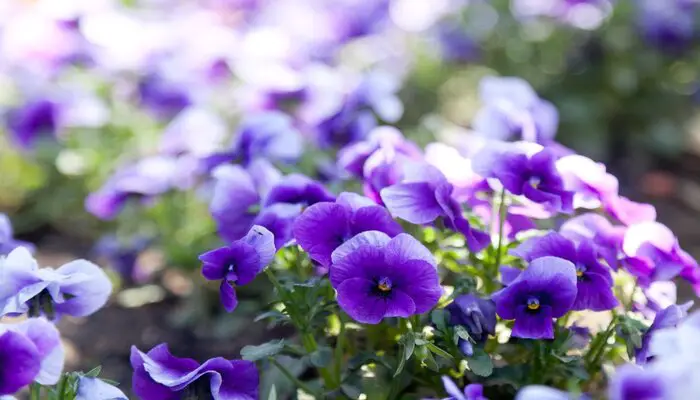
Belonging to the Violaceae family, violets are widespread everywhere including Italy and include about 400 species with an extraordinary variety of colors. The plants, delicate and very beautiful, can reach 20 cm in height and grow easily both in pots and in the garden, very appreciated because they allow you to create splendid decorations by adorning different corners of the house, both indoors and outdoors.
A delightfully scented Italian flower, the viola has bright green oval or heart-shaped leaves and flowers with five petals and one lower. All species of violets bloom in spring and usually stop in the summer season as they begin producing seeds for next spring. In Italy there are about 50 species of violets, among which the most common is the violet, well known and appreciated for its therapeutic properties and for its use in cosmetics and pastry.
Among the best known species there is also the pansy, a very resistant plant suitable for growing in the garden all year round. This plant tolerates the cold very well and also very rigid temperatures and is distinguished by the characteristic purple color it takes on during the spring.
In order not to attack the plant by parasites such as mites and moths, it is advisable to use sulfur-based products. As for the fertilization, it must be done during the growth phase and very gently, especially when the temperatures are lower.
The best time to grow violets is usually in autumn but they can also be planted in spring. Before transplanting the violets, work the soil well and make a hole at least 25 centimeters deep, taking care to remove stones and weeds and to soften the clods.
Before planting the violets, add some manure and mix well with the soil, then plant the seedlings taking care to position them at a distance of about 15 – 20 centimeters. If you want to obtain a lively and delightful chromatic effect, choose varieties of violets of different colors, so as to create real compositions of spotted flowers.
If you grow violets in the garden they do not require too much water and that of seasonal rains will suffice. It is in fact a very resistant plant and is suitable for cultivation both in the North and in Central Italy. It is clear that, if you encounter a rather hot summer period, they should be watered in moderation in order to keep the soil moist but never soaked.
15. Cyclamen
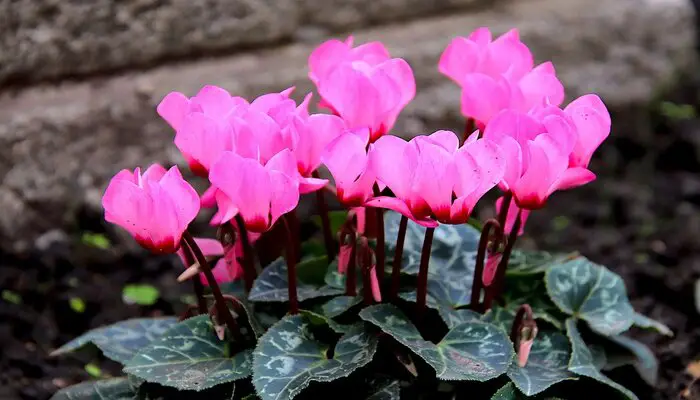
The cyclamen is an Italian flower that is part of the family of Primulaceae or Myrsinaceae, depending on the classification. The two most common varieties of cyclamen are Cyclamen persicum and Cyclamen purpurascens. Cyclamen has tuberous roots that are round in shape.
Cyclamen bloom from one season to the next, with flowers and leaves that develop from the root to the bulb. Depending on the variety, we will find cyclamen with colors ranging from white to red and pink to purple.
Cyclamen love cool, humid places . For flowering they prefer the autumn and winter season, between September and March. However, flowering may depend on the variety and the sowing period.
Usually the leaves of cyclamen are heart-shaped. In Italy we find cyclamen of alpine species, whose ideal habitat is represented by shady woods. They prefer soils rather calcareous, from basic pH and an average soil moisture. The exposure to too much sun can ruin the cyclamens.
Cyclamen is not a very simple plant to grow. Above all, it is difficult to make it bloom again, but with the right precautions you can admire its flowers even for 5 years in a row .
In autumn , during the growth phase of the leaves and flowers, you will have to place the cyclamen at a temperature not exceeding 15 ° . Better to keep it indoors, away from excessive cold, but not near the radiators. Only in regions where the winter climate is not too harsh, you will be able to move the cyclamen outside, but pay close attention to frosts . The advice is to always shelter the seedlings during the night.
You will find that the first cyclamen flowers will begin to appear between September and October . In spring and summer , however, the plant will be at rest and will not bloom.
Eliminate withered flowers and dry leaves. Place the cyclamen in a cool and shady area, watering only occasionally. The seedlings will seem lifeless, but they will be a bridge to bloom again in autumn. Occasionally, they may start shedding new leaves during a cool spring.
The sowing of the cyclamen takes place in summer, between July and September . The seeds of the cyclamen are very small. It may be useful to mix them with a little sand to facilitate distribution on the ground. You can sow cyclamen in a rectangular pot or in a tray. Spray the seeds with water so that the surface of the soil is always quite moist.
The advice is to cover the jar with a transparent plastic wrap, to help maintain a correct temperature and humidity. After a month you will see the first sprouts appear and you can remove the cover. Choose the most resistant plants and when they have grown you will transfer them to pots.
16. Jasmine
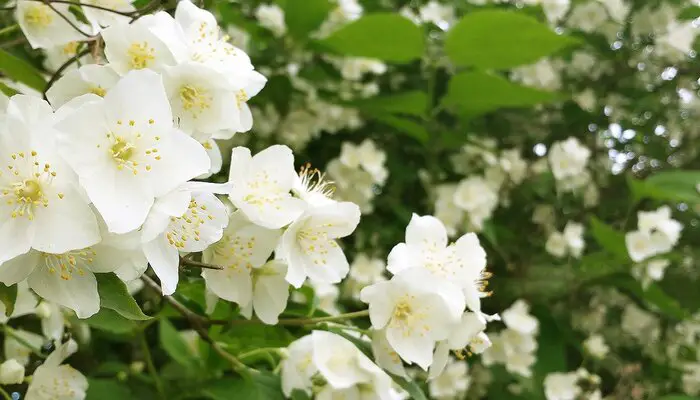
The jasmine is an evergreen shrub, belonging to the family oleaceae. Originally born in India, but then it was also transplanted to Europe, is appreciated for the sweet scent given off by its white and yellow starry flowers.
There are at least 200 different species of jasmine , although the most common are the jasminus officinale (capable of withstanding temperatures below zero), the grandiflorum (very delicate) and the humble jasminum.
Jasmine can be grown well in almost all of Italy, but in regions where temperatures frequently drop below -5 ° C in winter is it recommended to grow in pots, so as to be able to protect the plant in the cold months.
In regions with a mild climate, development is lush and flowering is abundant. The best exposure is the sunny one, with protection from the winds, preferably with plants leaning against a wall or a windbreak facing south.
We specify that this is a plant that adapts well to any type of climate and is easy to grow. However, it prefers sunny places, if it is kept in pots and in the house, it is advisable to place it near the windows or where there are light sources.
This italian flower needs direct light at least an hour a day, but also grows in the shade. In summer it does not suffer from heat, while in winter it does not like cold, at a temperature below zero the leaves fall and it is advisable to protect the roots from frost.
Avoid strong winds and plant jasmine near walls or near of other large plants. It resists drought, while water stagnations must not form which damage the plant. It is recommended to water every two weeks during the summer.
This plant was once used to extract an oil, considered one of the natural remedies to improve sexual life. Even today, jasmine flowers are associated with sensuality and sweetness.
If you want to grow jasmine at home , study the characteristics of your spaces well and then choose whether to plant it in pots on the balcony or let it grow in your garden.
17. Mimosa
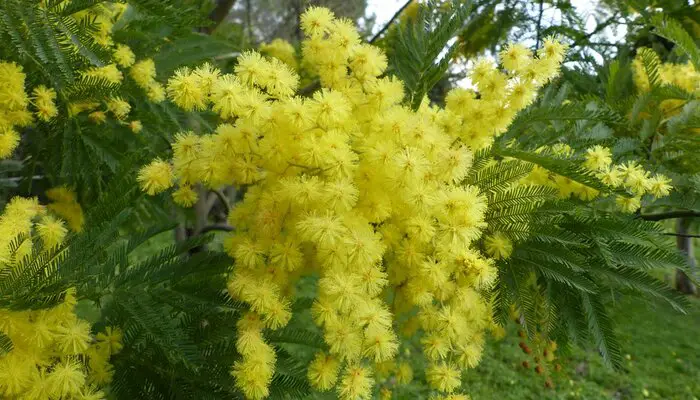
Mimosa is a genus that occurs in the Italian flora, comprising more than 400 different species. Mimosa pudica is one of the most cultivated species, also known as “ don’t touch me ”, due to the habit of its flowers bending when touched.
In Italy, there is a cultural custom of giving mimosas to women on International Women’s Day. That’s because the yellow color of its flowers would represent solidarity and feminism.
This Italian flower plant is considered an excellent decorative element. Many times it has been planted in small pots and planted as bonsai-style mimosas. And this is due to the stem, the flowers and their well-delineated leaves in the shapes of small ferns.
They are also a type of plants that are not usually as tall as the rest of the mimosa, the maximum growth of this specimen can be up to one meter in height.
Flowers and plants, in general, require certain care to stay alive and healthy. Therefore, the conditions in which a species is found will depend on the treatment that is given to it.
One of the first care that has to be taken into account for this type of plants is the location of the plant. These should not be placed in places where it is 100% exposed to the sun. In the case of mimosa pudicas, they only need to absorb 6 hours of sunlight daily.
Under no circumstances should the mimosa flower remain in freezing temperatures . If temperatures drop much more than 11 degrees Celsius, it is possible that the plant suffers serious consequences, even that it dies. It should be remembered that these types of Italian flowers require a characteristic climate of the tropical zone with considerable humidity indices.
18. Cornflower
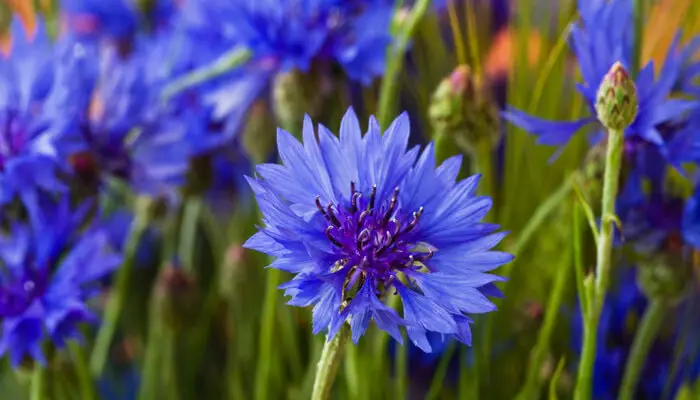
Although very beautiful Italian flower, cornflower often grows as a weed in Italian cornfields. For its beautiful flowers that can be blue, purple or pink, this plant is widely used in ornamental cultivation. Its flowers are also used in the preparation of teas.
Popularly, cornflowers are used as cut flowers that are given by boys in love to their beloved. If the cornflower withers too quickly, it means that the man’s love has not been returned.
For this use it is also known as the bachelor button flower in Italy. Another curiosity about the Italian cornflower is that it is used in cooking , in the preparation of sweet and savory dishes.
The cornflower is best known for its beautiful blue flowers, but it conceals many other treasures. This flower indeed has very powerful properties that are beneficial for the skin.
Cornflower is a plant of undoubted beauty that loves mild climates and soft , soft soils , rich in organic substances. The flowering of this plant normally occurs towards the end of May or August, depending on the variety. This plant loves full sun exposure and frequent watering, especially during flowering.
To have colorful and prosperous cornflower bushes , especially in the case of cultivation in pots, it will be essential to ensure good drainage to the plant . Arranging the pot with a bed of shards and gravel is very important to facilitate the flow of water.
The soil must be soft and rich in nutrients, perhaps previously enriched with compost . Fertilization is especially important for cultivation in the open ground and will need to be renewed on a monthly basis.
Characteristics of Italian Flowers
| Italian Flowers | Environment | Temperature | Maintenance | Adversity |
|---|---|---|---|---|
| Tulip | It prefers basic rather than clayey soils, which are well draining and never too humid; if the Tulip is planted in a pot, a thin layer of clay can be added which will give the soil a greater draining capacity. | The Tulip particularly loves hot and sunny places, however in case of excessively hot days, it is advisable not to expose it to direct sunlight, as the leaves could burn even if they are very resistant. It is recommended not to place it in areas with a strong current, as it strongly fears the wind. | The Tulip does not need a lot of water: it is advisable to water it carefully and without exceeding it only in case of rather prolonged periods of drought since usually the rain will be enough to irrigate the soil. It is necessary to increase the frequency of watering during the summer months but without exaggerating: the soil that is too humid and stagnant water are not at all appreciated by these flowers. | The Tulip is not immune from the threat of diseases and parasites: dangerous are snails, mice and ground insects, which tend to ruin the petals and leaves of the plant; frequent is the presence of fungi and molds, which can lead the tulip to death. |
| Orchid | Given that the climate of origin of the plant is in any case a tropical climate, attention must be paid to the humidity to be guaranteed in the microclimate that surrounds the Orchid. The exposure to the sun must be guaranteed but not necessarily direct, the important thing is that there is light and the environment is well ventilated. | The temperatures to be taken into consideration vary according to the growth phase of the plant. In the vegetative period, between spring and summer, an exposure to a medium hot temperature of around 24 °C is required. During development, the temperature can drop but not below 8 ° -10 °C. | In stony soils it is important to fertilize the orchid to provide the nutritional foods of which this type of soil is scarce. During the hot period it is necessary to water the orchid both at the roots and along the stem and leaves, so as to guarantee nebulization and avoid dryness. | The Orchid plant does not fear particular adversities except those related to the necessary humidity and exposure to the sun that is not too strong. |
| Chrysanthemum | The soil must be fertilized, drained and composed of a mixture of peat and sand. | You need to keep the chrysanthemum in a room with an optimal temperature between 18 and 20 °C . Be very careful in winter, if the temperature is between 13-18 degrees Celsius, the lifespan of the chrysanthemum is extended up to 8 weeks. | The chrysanthemum should be watered with an average amount of water, not too much, and the soil should remain fresh and not rotten. Otherwise, diseases or pests can occur. | Light is very important for chrysanthemums because it promotes growth. So, if you want to have a healthy and beautiful chrysanthemum, place it in bright places. |
| Sunflower | The sunflower needs sandy soils rich in organic matter. Besides, it has a great capacity to adapt to different soil conditions, being able to thrive in shallow, poor and acidic soils. | Sunflower cultivation gets used to different climatic conditions. For the flowering and ripening of the fruits it requires high temperatures, the ideal is between 20 and 25ºC. | Sunflower is a drought-resistant plant, due to the well-developed root system, the porosity of the plant, the fact that the leaves withstand temporary dehydration. However, the sunflower needs a large amount of water. A single sunflower plant consumes 70-80 liters of water throughout the vegetation period. Sunflower can be grown in areas where the average annual rainfall is between 350-600 mm/year. | Low light leads to etiolation of plants, reduction of leaf area, low temperatures and low yields. Also, the lack of light during the accumulation of lipids causes a low oil content in the seeds. |
| Daisy | You can use a natural, compost-type fertilizer, or a liquid fertilizer purchased from specialty stores that is rich in potassium. Added to the soil, the fertilizer of any kind has the role of nourishing the roots of the plant. | The cultivation of daisies is done in spring, after there is no danger of frost, and the temperature is a maximum of 16 degrees Celsius. | Daisies need water abundantly only on hot days. The rest of the time, you need to provide them with a moderate amount of water. It is best to constantly check the soil to see if it is dry or not. Since daisies withstand even dry conditions, if you water them too much, you run the risk of the roots rotting. | Daisies love the sun in abundance. Although it resists even on cold summer nights, the plant is damaged by shade. Therefore, daisies must benefit from as much sun as possible to bloom. To avoid the disease of daisies, it is advisable to use an insecticide that fights a variety of pests. It is also recommended to apply a fungicide before the buds develop so as to prevent the appearance of diseases. |
| Lavender | Lavender is a rustic plant that grows well in any type of soil, but largely prefers calcareous and clayey soils. It does not tolerate water stagnation, so the soil must be very well drained. The plant is suitable for steep soils, where the flow of water is favored and the very roots of the Lavender allow to keep the soil stable. | Lavender is a plant that prefers exposure to particularly bright places, even those affected by direct sunlight: it has no particular needs, but it is recommended to place it in well-ventilated positions. It is able to withstand sudden changes in temperature, but it would be advisable to protect it with a cloth during winter frosts. | The plant prefers watering neither too abundant nor too frequent: it is advisable to wait for the soil to dry the lanceolate leaves a little before providing more water; In general, it is preferable to leave Lavender dry for a few days, rather than having a substrate soaked in water. It should not be fertilized, but if you want, you can provide fertilizer at the beginning of the growing season, around April. Lavender needs a dry soil without stagnant water. Pruning should be done every year after flowering or in late winter to remove dry branches from cold temperatures | Lavender can be attacked by fungi and if it is necessary to eliminate the infected parts, air the place where the plant is kept, and if indoors, resort to a fungicide if the problem is not solved otherwise. Very often, the plant is also attacked by root rot: it is advisable to be careful in the supply of water, thus avoiding annoying water stagnations that are not tolerated at all. |
| Carnation | Carnations require well-drained, neutral to slightly alkaline soil and full sun. | The Carnation prefers a temperate climate. The ideal temperature must fluctuate from 10 ° C. and 20 ° C. The remontant carnations are grown in greenhouses and bloom at temperatures of about 10-12 degrees, if they are kept at 5 degrees during the winter they produce few flowers. | There are differences between a variety and the tall one but generally they are not particularly demanding plants. Watering can therefore be infrequent. Instead, it is essential to avoid water stagnation. If grown in pots, it is therefore necessary to prepare a bottom with a thick draining layer. It needs to be watered regularly in summer and during dry periods. | Carnation loves full sun, but also tolerates partial shade quite well. The important thing is that the area where it grows is dry and not humid. Some varieties of Carnations (in particular annuals) can be affected by powdery mildew, especially in years when the rains alternate with humid heat but also due to a poorly ventilated location. |
| Rose | Roses prefer soils with a loamy, permeable texture, well drained and rich in nutrients. Soils with an acid reaction and those with a strong alkaline tendency are not favorable. | Roses are flowers with a warm climate, so it is recommended to keep them in a place where you can have regular sun exposure. If you are in a colder area, you should try not to keep it for a long time at temperatures below 15 degrees. | You will need to water your rose often, especially during the warmer months. In fact, this plant likes to take direct sunlight for at least six hours a day, but it also needs to stay cool. Therefore the soil must always be moist, but water stagnations must not form. When watering, always direct the jet of water towards the base , as wet flowers and leaves are easy prey for fungi. | If your flower is prey to fungi, you will have to remove the damaged parts immediately . You will notice this because different types of spots may appear: whitish colored mold on buds and shoots, dark brown markings on the leaves, blackish and yellow-edged spots that start from the leaves and also expand on the stem and thorns. |
| Calla Lily | It needs very moist and nutrient-rich soil. If you grow it at home, it is necessary to place the pot half immersed in water, so as to make the environment and the soil sufficiently moist. | The ideal temperature for the development and vigorous growth of the Calla Lily varies between 8 ° and 12 ° C. This species does not tolerate very low temperatures very easily, for example below 6 ° C. The Calla Lily prefers bright locations, but preferably without receiving direct sunlight. | Watering must be frequent and increased during the vegetative period. It is advisable to help yourself in the operation with saucers full of water. Only when the flowers begin to rot or dry out is it necessary to reduce watering. They must be permanently suspended in the summer season. | The Calla Lily flower can be subject to attacks by scale insects and red spider mites. In the first case, it is possible to eliminate the infestation with a wad soaked in water and alcohol; in the second case, since the cause is often a too dry environment, it is advisable to increase the ambient humidity and intervene with specific acaricides. |
| Lily | Garden lilies need drained, fertile soil that contains significant amounts of humus. | Lilies are not pretentious flowers, so they can be planted in sunny as well as semi-shady places. Areas that are exposed to the sun or shady throughout the day affect the optimal growth of plants and their flowering. | The care of garden lilies involves watering them in moderate quantities. Throughout the growing and flowering period, lilies should be watered at least once a week or even several times, if necessary, to keep the soil moist. | To stimulate the harmonious growth of garden plants, it is advisable to use liquid or water-soluble fertilizers. It should be noted that they must be intended for the development of decorative plants through flowers. |
| Freesia | They are plants that prefer soft soil, rich in organic substance and above all well drained. The ideal growing medium is a mixture of common universal soil, peat and sand | Freesias love bright, sunny places for many hours a day. The plants fear frost and for this reason in regions with a very harsh winter climate they should be grown in pots so that they can be sheltered indoors during the period of vegetative rest if you want to avoid removing the corms or bulbs. | The freesias require regular watering until the end of flowering and suspended when the leaves wither. The amount of water administered must be moderate to avoid soaking the soil and avoid rotting of the bulbs. | In general, most freeze problems come from the quality of the bulbs. If they are moldy or soft to the touch, throw them away. It is also recommended to spray the bulbs with insecticides and fungicides in autumn and winter. There is also the danger of aphids, especially in the case of garden freesias. But if you treat them with insecticide, you eliminate this danger. It is good to apply phytosanitary treatments with insecticides and fungicides once every 3-4 weeks. |
| Oleander | Oleander is a very rustic species that adapts to all types of soils, the most suitable being that which contains a good base of limestone (carbonates and calcium), a basic pH above 7 and good drainage | It supports all types of environments and temperatures, although it prefers warm weather over cold. It can be grown in full sun and with temperatures that exceed 40ºC in summer. | Watering during the summer is done in abundance so as not to risk drying the soil. In winter it can be watered with a smaller amount of water and at longer intervals. (for example, twice a month). | It is grown in full sun and is not affected by summer heat or total sun exposure. The whole plant is poisonous , including the juice that comes out after a cut; attention to children and pets. |
| Peony | Prefer light and alkaline soils. | If you choose to plant peonies in the fall, from September to October, the bulbs will have enough time to acclimatize. Peonies are cold-resistant perennials, successfully withstanding temperatures of – 27 ° C. However, peonies bloom just as beautifully if they are planted in May, when the danger of the first frost has long passed and the temperatures are favorable. | There are plants that need significant irrigation that grow more and more with the increase of the flowering phase and external temperatures. Always keep track of the terrain; this should never be excessively dry, but neither should the water stagnate which could cause the root to rot. | Peonies are not particularly prone to insects and parasites, a remodeling pruning and a topping to favor floral development will be more than enough to make it grow healthy and luxuriant. |
| Violet | Violets needs permeable, fertile, moist soil with good drainage. It does not tolerate water stagnation. | Violets are very hardy. They resist frosts and full sun in spring. The preferred climate is temperate, tending to cold. In any case, the violets can bloom even in winter if adequately sheltered from the elements. In summer, the plant needs a more protected position to keep the flowers. | It must be watered in moderation, every 15 days maximum, in the coldest months and always on days when there are no frosts. | Violets are robust plants, but they are not free from adversity: sporadically they can be attacked by black aphids, snails, whiteflies , gray mold, and false powdery mildew. The flowers should not be wet as the water leaves marks that could lead to the wilting of the specimen. |
| Cyclamen | Opt for a soil rich in organic substances and well drained: if you choose the cultivation in pot, prefer the terracotta ones as they allow the soil to drain without the formation of stagnations. | The cyclamen plant also needs good ventilation to avoid moisture that could damage the leaves. However, pay attention to frosts and cold wind: however, if you live in temperate areas you can leave the cyclamen on the terrace for the whole winter. In the fall, place the plant at a temperature no higher than 15 degrees. | Water the cyclamen regularly, avoiding excess water and stagnation: especially avoid wetting the leaves and flowers in order to avoid the formation of mold. Make sure that the soil does not stay dry for too long between waterings and remove the water from the saucers. | The most common pests for cyclamen are fungi that can affect the leaves and roots. |
| Jasmine | To grow jasmine in the garden, the ideal soil is medium-textured , well-drained, with a good amount of organic substance and neutral pH. When preparing the soil, a good basic fertilization is recommended using domestic compost, earthworm humus or mature manure. | They are resistant to temperatures down to -15 ° C. They must be protected in regions with very cold winters. | Both in pot and outdoors, jasmine need watering every time its soil has dried on the top layer. Do not puddle when watering, and pay special attention to the water in the warm months. | It can happen that jasmine is infested with parasites. The most fearsome for this plant are aphids and cochineal. For both, the advice is to intervene promptly at the first signs of infestation, using potassium soft soap. |
Conclusion
Flowers are very present in Italy, both filling the wild fields in spring, and in the cut flower trade, which is very heated throughout the year.
Since flowers play an important role in Italian culture, there are some tips you should know if you plan to give or send flowers to an Italian. The color of the flowers has a symbol for them, so do not give red flowers as they represent secrets, while yellow ones show jealousy.
Unless you are sending flowers out of condolences, never send chrysanthemums, as in Italy they are used strictly for funerals. If you were invited to a dinner party and you want to send flowers to the hosts, have your flowers delivered the day before dinner.
In this article we presented you the most common Italian Flowers and a few details about each one. How many of these Italian Flowers did you knew?
Which flower on the list of Italian species did you like the most? Which one would you like to grow in your home?
Frequently Asked Questions
Which flower is the national flower of Italy?
The national flower of Italy is the lily and symbolically represents purity and refined beauty. Based on color and type, lilies have different meanings.
The national flower of Italy is the daisy. Also called perennial bellis, a small sticky shrub with flowers with white petals and a yellow center. They have starred in countless stories, both legends and literary works themselves.
What is the most popular flower in Italy?
The peonies are very popular in Italy and is popularly known as ” rose without thorns “. Due to its popular cultivation, today there are more than 250,000 varieties of peonies, in the most varied colors, shapes and scents.
Peonies are also plants rich in symbolism and meaning. Each peony color can mean one thing. White peonies, for example, can represent an apology. Pink peonies can be a dating request, or a good-luck gift, wishing you prosperity. The red peonies represent passion, libido.
What are the purple flowers that grow in Italy?
Periwinkle , bellflower , geranium , pansy ( viola tricolor ), violet (or viola odorata) and orris ( iris germanica ) are just some of the more common purple flowers. Hyacinth and lavender are ubiquitous in summer fields, but lilac ( syringa vulgaris) is also a widespread fragrant shrub that blooms in spring.

